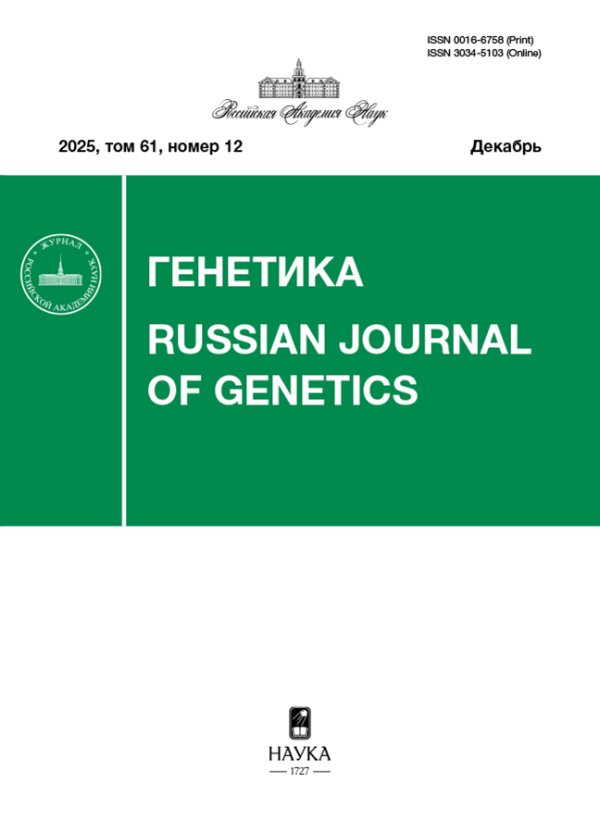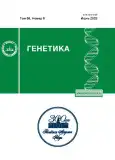Том 59, № 6 (2023)
ОБЗОРНЫЕ И ТЕОРЕТИЧЕСКИЕ СТАТЬИ
Патогенетика кардиомиопатий
Аннотация
Анализируется значимость генетических факторов в развитии как первичных (или менделевских) кардиомиопатий (КМП), так и некоторых вторичных (приобретенных) форм КМП. Для первичных КМП описаны десятки генов с патогенными/вероятно патогенными вариантами. В большинстве случаев спектр причинных генетических вариантов для разных КМП специфичен, но регистрируются также общие гены и варианты. При этом, с одной стороны, не для всех случаев первичных КМП установлены генетические причины заболеваний, а с другой, патогенные варианты в генах менделевских КМП регистрируются и при вторичных КМП. Генетический компонент в развитии и первичных и вторичных КМП установлен также при проведении широкогеномных ассоциативных исследований (GWAS). Однонуклеотидные варианты (SNPs), ассоциированные и с первичными, и со вторичными КМП, в большинстве случаев специфичны для разных КМП и вносят небольшой вклад в риск развития патологий. Для некоторых SNPs установлены ассоциации с ЭКГ- и Эхо-кардиографическими параметрами морфологически неизмененного сердца у человека. Большинство из SNPs, ассоциированных с КМП по данным GWAS, локализованы в некодирующих участках генома, но обладают регуляторным потенциалом, выступая в ткани сердца в качестве локусов, влияющих на уровень экспрессии (eQTL), сплайсинг (sQTL) или эпигенетические модификации. Примечательно, что эффекты генотипов eQTL и sQTL в ряде случаев неравнозначны для различных анатомических отделов сердца. В целом фенотип и клиническая картина КМП могут определяться широким спектром редких патогенных/вероятно патогенных вариантов с сильным эффектом и частых высокополиморфных вариантов с небольшим эффектом и модифицироваться эпигенетическими факторами.
 615-632
615-632


Сравнительный анализ линий Y-хромосомы древних и современных саха (якутов)
Аннотация
В обзоре представлены результаты палеогенетических исследований древнего населения Якутии эпохи средневековья. Рассмотрен спектр гаплогрупп и STR-гаплотипов Y-хромосомы 74 мужчин из якутских погребений XV–XIX вв. в сравнении с данными по современным этногеографическим группам якутов. Проведено сопоставление генетических реконструкций с историческими преданиями народа саха.
 633-639
633-639


ГЕНЕТИКА МИКРООРГАНИЗМОВ
Изучение генетического разнообразия возбудителя пирикуляриоза риса Pyricularia oryzae Сav. по комплексу молекулярных и морфологических признаков
Аннотация
На основе молекулярно-генетических подходов проведено изучение биоразнообразия фитопатогенного гриба Pyricularia oryzae Cav. на юге России и проведена классификация морфолого-культуральных и генетических признаков патогена. За 2020–2022 гг. проведен мониторинг и выделено 24 штамма патогена из пораженного гербарного материала, собранного с полей пяти экологических рисосеющих зон Краснодарского края (Красноармейского, Калининского, Абинского, Славянского районов, Краснодар). С использованием мультиплексной системы ПЦР на основе фрагментного анализа среди изученных штаммов Pyricularia oryzae Cav. за весь период выполнения проекта выявлено пять генотипов, каждый из которых характеризуется уникальным генетическим профилем. Составлены их “ДНК-паспорта”. Изученные изоляты возбудителя пирикуляриоза охарактеризованы по морфолого-культуральным признакам. Выделено шесть морфотипов патогена.
 640-647
640-647


ГЕНЕТИКА РАСТЕНИЙ
Динамика распространения ржаных транслокаций в генотипах российских сортов мягкой пшеницы Triticum aestivum L.
Аннотация
Широкое использование в селекции пшеницы сортов с транслокациями 1RS/1BL и 1RS/1АL было обусловлено их высокой комплексной устойчивостью за счет генов резистентности на 1RS-хромосомах. Многочисленные сведения о появлении новых вирулентных рас патогенов и потере генами, локализованными на 1RS, своих защитных свойств делают актуальным решение вопроса о перспективности использования обеих ржаных транслокаций в современных селекционных программах. Кроме того, использование в интрогрессивной гибридизации различных генетических источников ржаной хромосомы 1RS ставит задачу изучения разнообразия групп сцепления 1RS. Нами исследована динамика распространения ржаных транслокаций в генотипах 240 российских сортов мягкой пшеницы из трех селекционных центров РФ. Для маркирования 1RS использовались множественные аллели генов запасных белков, специфичных для 1RS. Выявлено, что гены устойчивости на 1RS по-прежнему эффективны против ряда патогенов, в частности против возбудителей мучнистой росы и стеблевой ржавчины. Прослежена динамика изменения качества зерна сортов с TR:1RS/1BL. Подтверждено статистически достоверное его улучшение у озимых сортов начиная с 2000-х гг., а у яровых сортов присутствие в генотипах TR:1RS/1BL не препятствует получению зерна с высоким уровнем качества. Показано, что в результате этих процессов во всех трех селекцентрах идет накопление TR:1RS/1BL во времени. Показано высокое аллельное разнообразие секалин-кодирующего локуса (Gli-B1) на хромосоме 1RS. Однако все сорта с TR:1RS/1BL независимо от происхождения 1RS несли один и тот же аллель. Обсуждаются возможные причины такого единообразия. Транслокация 1RS/1АL в исследованных нами сортах не выявлена, обсуждаются возможные причины.
 648-658
648-658


ГЕНЕТИКА ЧЕЛОВЕКА
Анализ генетических факторов спорадических случаев шизофрении в семейных трио с использованием метода полногеномного секвенирования
Аннотация
Шизофрения – распространенное психическое заболевание, наследственная природа которого подтверждена многочисленными исследованиями. В настоящее время выявлено более сотни генетических локусов, ассоциированных с шизофренией, также идентифицированы редкие варианты в генах и хромосомные перестройки, связанные с семейными случаями заболевания. Однако не всегда удается определить наследственную природу патологии, многие случаи шизофрении являются спорадическими, а генетическая причина таких случаев остается неизвестна. С использованием данных полногеномного секвенирования трех семейных трио российского происхождения со спорадическими формами шизофрении мы провели поиск редких потенциально патогенных вариантов в кодирующих и регуляторных локусах генома, включая de novo и компаундные мутации. Также провели оценку полигенного риска развития шизофрении с использованием распространенных полиморфных маркеров. В результате проведенного анализа были показаны генетическая гетерогенность спорадических форм шизофрении, а также потенциальный вклад редких замен в генах, связанных с метаболизмом глутамата и инозитолфосфата, в развитие спорадических случаев шизофрении.
 659-669
659-669


Повышенный уровень лизосфинголипидов крови у пациентов с шизофренией
Аннотация
Шизофрения представляет собой психическое расстройство и характеризуется нарушением передачи дофамина в нейронах. Последние данные показали, что лизосомные болезни накопления (ЛБН), сопровождающиеся снижением активности ферментов и соответствующим накоплением субстрата в лизосомах из-за мутаций в лизосомных генах, могут проявляться широким спектром клинических проявлений, включая психозы, аффективные расстройства, деменцию с ранним началом и шизофренией. Цель настоящего исследования заключалась в оценке уровня лизосфинголипидов у пациентов с шизофренией, болезнью Паркинсона (БП) и контроле. В исследование включены 52 пациента с шизофренией, 170 пациентов с БП и 166 неврологически здоровых лиц (контрольная группа). Концентрацию лизосомных субстратов (гексозилсфингозин (HexSph), глоботриаозилсфингозин (LysoGb3), лизосфингомиелин (LysoSM)) определяли высокоэффективной жидкостной хроматографией в сочетании с тандемной масс-спектрометрией (ВЭЖХ-МС/МС) в крови. Выявлено повышение концентрации LysoSM, LysoGb3, HexSph у пациентов с шизофренией по сравнению с контролем (p < 0.0001, p < 0.0001, p < 0.0001 соответственно). Наши результаты подтверждают нарушение лизосфинголипидного состава крови у пациентов с шизофренией.
 670-675
670-675


МАТЕМАТИЧЕСКИЕ МОДЕЛИ И МЕТОДЫ
Влияние 3Д-организации хроматина на суперэнхансер–промоторные взаимодействия в эмбриональных стволовых и злокачественных клетках
Аннотация
Взаимодействие энхансеров и суперэнхансеров (СЭ) с промотором функционально значимо для регуляции экспрессии генов. Паттерны этих взаимодействий играют ключевую роль в регуляции таких процессов, как дифференцировка, злокачественная трансформация и др. Чтобы получить количественную информацию о взаимосвязи структуры хроматина и экспрессии генов, в настоящей работе был проведен компьютерный анализ конформаций хроматина вблизи гена плюрипотентности Nanog мыши, включая контакты СЭ c промотором, в нормальных эмбриональных стволовых (mESC) и в клетках лимфомы (CH12LX). С помощью биофизических методов моделирования идентифицированы параметры суперэнхансер-промоторных взаимодействий – распределения расстояний между промотором Nanog и СЭ, частоты контактов с одним и несколькими СЭ одновременно. В нормальных mESC частота контактов промоторов с СЭ выше, чем в злокачественных, и чаще образуются сложные контакты, с двумя и более СЭ. В злокачественных клетках обнаружена малая субпопуляция клеток, где промотор контактирует одновременно с тремя СЭ. Субпопуляции злокачественных клеток с множественными контактами промотор–СЭ могут предрасполагать к проявлению свойств стволовых клеток и гипотетически быть кандидатом на опухолевые стволовые клетки.
 676-686
676-686


Сравнительный анализ инструментов для поиска структурных вариантов на данных короткоридового полногеномного секвенирования
Аннотация
Проанализирована работа трех биоинформатических инструментов (Manta, Smoove, Delly) для поиска структурных вариантов на данных полногеномного секвенирования с использованием четырех разных алгоритмов выравнивания: DRAGEN, GDC DNA-SeqAlignment Workflow, GDC DNA-SeqAlignmentWorkflow + GDC DNA-SeqCo-cleaning Workflow, NovoAlign, разных длин “сырых” прочтений: 2 × 150 и 2 × 250 пн, разных показателей среднего покрытия генома. Полученные показания соотнесены с эталонными результатами команды GIAB. Проведена проверка выявленных структурных вариантов с помощью секвенирования по методу Сэнгера. Выявили, что структурные варианты типа делеция и инсерция лучше всего определяются с помощью инструмента Manta. Мы получили 89–96% точности и 59–70% чувствительности для проанализированных делеций, а также 96–99% точности и 15–36% чувствительности для инсерций. Smoove и Delly продемонстрировали менее точные и чувствительные результаты (Smoove: 91–95% точности и 8–54% чувствительности для делеций; Delly: 78–87% точности и 31–66% чувствительности для делеций, 99–100% точности и 1–13% чувствительности для инсерций). Показали, что использование комбинации из двух и даже трех инструментов не повышает процента подтвержденных структурных вариантов для типов делеция, инсерция, дупликация. Проведенный анализ выявил, что с увеличением среднего значения покрытия генома увеличиваются показатели точности и чувствительности работы биоинформатических инструментов для поиска структурных вариантов, а увеличение длины прочтений с 150 до 250 пн влияет в разной степени на точность и чувствительность работы отдельных инструментов. Также сделали вывод, что точность работы инструментов для поиска структурных вариантов варьируется в зависимости от диапазона размеров структурных вариантов. Например, Manta лучше находит делеции в диапазоне от 200 и более пн, Delly – от 1000 до 10 000 пн, Smoove – от 200 до 10 000 пн.
 687-707
687-707


О генетической дивергенции миграционно-связанных популяций: современное моделирование по результатам экспериментов Ю.П. Алтухова с соавторами
Аннотация
С точки зрения популяционной генетики возможность существования устойчивых различий на однородном по отбору ареале выглядит несколько парадоксально, однако именно дизруптивный отбор способен привести к такой дивергенции. Примеры популяционных систем с устойчивой дивергенцией генетических структур субпопуляций, обитающих на однородном ареале, встречаются в природе и создаются экспериментально. Сопоставление этих наблюдений и результатов моделирования дает возможность объяснить сохранение устойчивости природной генетической дивергенции механизмом взаимодействия дизруптивного отбора (в виде пониженной приспособленности гибридных форм) и слабого миграционного процесса. Хорошо согласуются с этим утверждением результаты экспериментов, выполненных Ю.П. Алтуховым и соавторами с ящичными популяциями Drosophila melanogaster, в которых была получена первичная дивергенция генетических структур субпопуляции по локусу α-ГДГ. Можно предположить, что существенную роль в поддержании этой дивергенции сыграло наличие дизруптивного отбора, в данном случае – пониженной приспособленности гетерозигот по α-ГДГ. Альтернативной гипотезой является закрепление различий в результате генетического дрейфа. Для того чтобы, с одной стороны, выявить и обосновать возможность наличия этого фактора в данной системе, а с другой, – оценить насколько существенную роль играет дизруптивный отбор в поддержании устойчивости первичной генетической дивергенции, в настоящей работе мы проанализировали математические модели динамики частот аллелей в большой панмиктичной популяции и в системе из 30 локальных миграционно-связанных популяций. Сопоставление результатов моделирования с результатами эксперимента позволяет заключить, что с большой вероятностью в рассматриваемой искусственной популяционной системе имел место дизруптивный отбор по локусу α-ГДГ, который способствовал первичной генетической дивергенции.
 708-717
708-717


КРАТКИЕ СООБЩЕНИЯ
Репарация ДНК не инициирует генетическую нестабильность дрожжевых клеток
Аннотация
Приводятся экспериментально полученные кривые зависимости задержки формирования колоний от дозы ионизирующего излучения (гамма-кванты 60Со, мощность дозы 10 Гр/мин) для шести штаммов гаплоидных и диплоидных дрожжей дикого типа (способных восстанавливаться от радиационных повреждений и характеризующихся сигмоидными кривыми выживаемости), а также для шести гаплоидных и диплоидных радиочувствительных мутантов, дефектных по репарации и характеризующихся экспоненциальными кривыми выживаемости. Задержка формирования колоний после облучения является проявлением генетической нестабильности. Показано, что для всех диплоидных штаммов генетическая нестабильность достигала 100% с увеличением дозы ионизирующего излучения, независимо от формы кривых выживаемости и способности клеток восстанавливаться от радиационных повреждений. Наоборот, для всех гаплоидных штаммов генетическая нестабильность была близка к 20%. В отличие от традиционных представлений, полученные нами данные указывают на то, что позднее формирование колоний выжившими после облучения клетками определяется главным образом плоидностью клеток и не зависит от формы кривых доза-эффект и радиочувствительности клеток. Это означает, что репарация ДНК не инициирует генетическую нестабильность дрожжевых клеток.
 718-722
718-722


Идентификация гибридных особей скальных ящериц Darevskia armeniaca × Darevskia valentini на основе микросателлитного генотипирования
Аннотация
В работе представлены результаты микросателлитного генотипирования гибридных ящериц D. armeniaca × D. valentini из симпатрических популяций Армении. По совокупности локусов Du281 и Du47G идентифицированы триплоидные особи и определено их происхождение. Показано, что гибриды содержат как аллели материнского партеновида – D. armeniaca, так и аллели отцовского вида – D. valentini.
 723-727
723-727


Генетическая вариабельность локуса гена МАОА у агрессивных животных неканонической поведенческой модели Neogale vison
Аннотация
Роль гена MAOA в процессах регуляции агрессивного поведения у человека и животных широко известна. В рамках данного исследования мы впервые провели анализ генетической вариабельности гена MAOA и его промоторной области у представителей неканонической поведенческой модели – американской норки (Neogale vison). Проведенный анализ не выявил значимых генетических изменений животных из линии, характеризующейся агрессивным поведением, что позволяет предположить наличие генетических и/или эпигенетических вариаций в других системах, связанных с регуляцией агрессии, у данной модели.
 728-732
728-732












